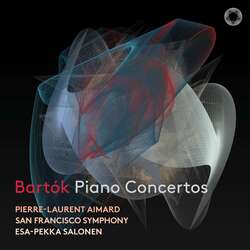Nach seiner Einspielung der drei Bartok-Konzerte mit Yefim Bronfman und dem Los Angeles Philharmonic im Jahre 1995 kehrt Salonen mit dem San Francisco Symphony und Pierre-Laurent Aimard zu diesen drei Werken zurück.
Von den Tempi her hat sich nicht viel geändert. Bemerkenswert ist auch der Dialog zwischen dem Orchester und dem Solisten. Doch der Eindruck, der von der neuen Einspielung vermittelt wird, ist ein ganz anderer als jener der Bronfman-Aufnahme. In San Francisco klingt Bartok kräftiger, sonorer, perkussiver und das mit mehr Nachdruck. In Los Angeles gab es mehr Raffinement, ein insgesamt rassigeres Spiel und vor allem mehr Atmosphäre.
Und ähnlich wie Yefim Bronfman und Esa-Pekka Salonen sich um ein gestochen scharfes klares Spiel bemühten, das trotz dieser Schärfe Atmosphäre hat, gehen auch Aimard und Salonen vor. Aber vom spannungsvollen, sphärisch-transzendierenden Lyrismus der langsamen Sätze sind wir in der neuen Interpretation sehr weit entfernt. Und auch in den schnelleren Sätzen erzeugten Salonen und Bronfman mehr Spannung. Der Vergleich ist also vernichtend für die neue Pentatone-CD.
Wer eine phänomenale Bartok-Aufnahme sucht, sollte die aus Los Angeles wählen, die immer noch bei Sony erhältlich ist, heute in einem deutlich besseren Mastering als im Falle der ersten Ausgabe.
After his 1995 recording of the three Bartok concertos with Yefim Bronfman and the Los Angeles Philharmonic, Salonen returns to these three works with the San Francisco Symphony and Pierre-Laurent Aimard.
In terms of tempi, not much has changed. The dialogue between the orchestra and the soloist is also remarkable. But the impression conveyed by the new recording is quite different from that of the Bronfman recording. In San Francisco, Bartok sounds more powerful, sonorous, percussive, and that with more emphasis. In Los Angeles, there was more refinement, overall racier playing and, above all, more atmosphere.
And much as Yefim Bronfman and Esa-Pekka Salonen strove for pin-sharp clear playing that had atmosphere despite that sharpness, Aimard and Salonen take a similar approach. Yet we are very far from the tense, spherical-transcending lyricism of the slow movements in the new interpretation. And even in the faster movements, Salonen and Bronfman generated more tension. So the comparison is unfavorable for the new Pentatone CD.
Those looking for a phenomenal Bartok recording should choose the one from Los Angeles, still available from Sony, today in a much better mastering than in the case of the first issue.


















